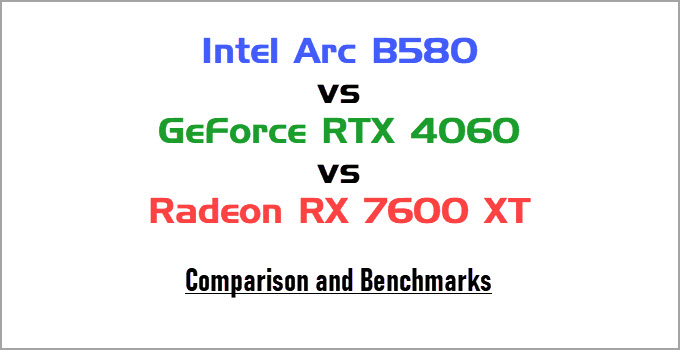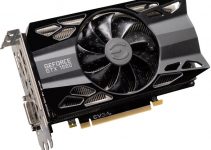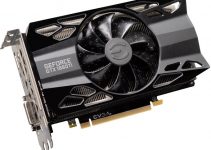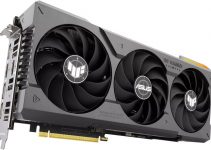Intel has finally up its game in the graphics card segment with the launch of its Arc B580 graphics card. Intel Arc B580 is targeted towards the budget mid-range or mainstream segment and is priced very competitively. Arc B580 has various improvements, fixes, and additions to its previous graphics card models. The major competitors of Intel Arc B580 are Nvidia GeForce RTX 4060 and AMD Radeon RX 7600 XT. The excellent price-to-performance ratio of Arc B580 has made quite a name already and has been getting favorable reviews from popular tech reviewers and websites. So, if you want to find out what Intel Arc B580 offers and how well it performs against RTX 4060 and RX 7600 XT in all major areas, please go through the comparison below.

Intel Arc B580 vs RTX 4060 vs RX 7600 XT Comparison
Below is a quick comparison between Arc B580, RTX 4060, and RX 7600 XT graphics cards based on their specifications, performance, pricing, power consumption, and features.
GPU Architecture
Intel Arc B580 is based on the Xe2 GPU architecture codenamed “Battlemage.” It uses the BMG-G21 chip and is built on the TSMC N5 (5 nm EUV) manufacturing process. The card has 20 Xe2 Cores (128 execution units per core translating to 2560 Unified Shaders), 20 Ray Tracing Units/Cores, and 160 XMX matrix accelerators or tensor cores for AI-related tasks and processing.
Nvidia GeForce RTX 4060 is based on the Ada Lovelace GPU architecture and is built on a 5nm TSMC manufacturing process. It uses an AD107 GPU Chip with 3072 CUDA Cores, 24 RT Cores, and 96 Tensor Cores for AI-related tasks and processing.
Radeon RX 7600 XT from AMD is built on RDNA 3 GPU architecture on a 6nm fabrication process and uses a Navi 33 GPU chip. It has 2048 Stream Processors, 32 Ray Accelerators, and 64 AI Accelerators.
| Intel Arc B580 | RTX 4060 | RX 7600 XT | |
| GPU Chip | BMG-G21 | AD107 | Navi 33 |
| GPU Architecture | Xe2 Battlemage | Ada Lovelace | RDNA 3 |
| Fabrication Process | 5nm | 5nm | 6nm |
| GPU Cores | 20 Xe Cores (2560 Shader Units) | 3072 CUDA Cores | 2048 Stream Processors |
| Ray Tracing Cores | 20 | 24 | 32 |
| Tensor Cores | 160 | 96 | 64 |
Video RAM [VRAM]
Intel Arc B580 has 12 GB GDDR6 memory with a bus width of 192-bit. The memory runs at a speed of 19 Gbps and delivers a bandwidth of 456 GB/s, the highest among its competitors in this comparison. RTX 4060 comes with 8GB GDDR6 memory, which is the lowest in this comparison. The memory bus interface is 128-bit and runs at 17 Gbps, delivering a bandwidth of 272 GB/s. On the other hand, the Radeon RX 7600 XT offers 16 GB GDDR6 memory, the highest in this comparison. Its memory interface is 128-bit and runs at a speed of 18 Gbps, delivering a bandwidth of 288 GB/s. RX 7600 XT also comes equipped with 32MB Infinity Cache, an ultra-fast cache that can help achieve peak memory bandwidth (burst memory bandwidth) of up to 477 GB/s for a short time.
| Intel Arc B580 | RTX 4060 | RX 7600 XT | |
| Memory Size | 12 GB GDDR6 | 8 GB GDDR6 | 16 GB GDDR6 |
| Memory Interface | 192-bit | 128-bit | 128-bit |
| Memory Speed | 19Gbps | 17Gbps | 18 Gbps |
| Memory Bandwidth | 456 GB/s | 272 GB/s | 288 GB/s |
| Infinity Cache | NA | NA | 32MB |
Features
All these graphics cards support DirectX 12 Ultimate, OpenGL 4.6, and Vulkan and support variable refresh rate technologies (G-Sync/FreeSync) to reduce stuttering in games for a butter smooth gaming experience, PCI Express 4.0, Real-Time Ray Tracing, HDMI 2.1, hardware AV1 encoding/decoding. Even though all three cards support a PCIe 4.0 interface, the PCIe lanes/bandwidth is limited to x8 only. This may cause a slight performance reduction in some games, with motherboards having only a PCIe 3.0 interface.
Regarding image upscaling technology to increase frame rate or FPS in games, Intel Arc B580 has XeSS Super Resolution (XeSS-SR), RTX 4060 uses DLSS 3 (Deep Learning Super Sampling), while RX 7600 XT has AMD FidelityFX Super Resolution (FSR 3). Arc B580 and RX 7600 XT support DisplayPort 2.1 (supports 8K Display Resolution at 60Hz), while RTX 4060 does not and supports DisplayPort 1.4a.
| Intel Arc B580 | RTX 4060 | RX 7600 XT | |
| Bus Interface | PCIe 4.0 x8 | PCIe 4.0 x8 | PCIe 4.0 x8 |
| DirectX | 12 Ultimate | 12 Ultimate | 12 Ultimate |
| OpenGL | 4.6 | 4.6 | 4.6 |
| Vulkan | 1.3 | 1.3 | 1.3 |
| VR Ready | Yes | Yes | Yes |
| G-Sync/FreeSync | Yes | Yes | Yes |
| HDMI 2.1 | Yes | Yes | Yes |
| DisplayPort 2.1 | Yes | No | Yes |
| AV1 Support (Encode/Decode) | Yes | Yes | Yes |
| Real-Time Ray Tracing | Yes | Yes | Yes |
| Image Upscaling Technology | XeSS Super Resolution (XeSS-SR) | Deep Learning Super Sampling (DLSS 3) | FidelityFX Super Resolution (FSR 3) |
Gaming Performance
Here are the gaming benchmarks of these graphics cards at 1080p and 1440p resolution in the latest AAA games.
1080p Gaming Benchmarks

1440p Gaming Benchmarks

From the above benchmarks, we can see that Intel Arc B580 beats both RTX 4060 and RX 7600 XT in most games by a decent margin. On average, it is around 5 percent faster than the RX 7600 XT and 7 percent faster than the RTX 4060.
Power Consumption
The maximum power consumption of Intel Arc B580 and RX 7600 XT is 190W, while RTX 4060 consumes less power with a power consumption figure of 115W.
| Intel Arc B580 | RTX 4060 | RX 7600 XT | |
| Power Consumption | 190W | 115W | 190W |
| Recommended PSU | 600W | 550W | 600W |
Pricing & Availability
The base MSRP of Intel Arc B580 is 249 USD, the lowest in this comparison. The official base MSRP for RTX 4060 is 299 USD, and for RX 7600 XT, it is 329 USD. The AIB custom models of these cards may cost more, and you can check the latest prices of these cards from the links below.
Check Price of Intel Arc B580 on Amazon
Check Price of RTX 4060 on Amazon
Check Price of RX 7600 XT on Amazon
Intel Arc B580 vs RTX 4060 vs RX 7600 XT Specifications
| Intel Arc B580 | RTX 4060 | RX 7600 XT | |
| GPU Chip | BMG-G21 | AD107 | Navi 33 |
| GPU Architecture | Xe2 Battlemage | Ada Lovelace | RDNA 3 |
| Fabrication Process | 5nm | 5nm | 6nm |
| GPU Cores | 20 Xe Cores (2560 Shader Units) | 3072 CUDA Cores | 2048 Stream Processors |
| Ray Tracing Cores | 20 | 24 | 32 |
| Tensor Cores | 160 | 96 | 64 |
| Memory Size | 12 GB GDDR6 | 8 GB GDDR6 | 16 GB GDDR6 |
| Memory Interface | 192-bit | 128-bit | 128-bit |
| Memory Speed | 19Gbps | 17Gbps | 18 Gbps |
| Memory Bandwidth | 456 GB/s | 272 GB/s | 288 GB/s |
| Bus Interface | PCIe 4.0 x8 | PCIe 4.0 x8 | PCIe 4.0 x8 |
| DirectX | 12 Ultimate | 12 Ultimate | 12 Ultimate |
| OpenGL | 4.6 | 4.6 | 4.6 |
| Vulkan | 1.3 | 1.3 | 1.3 |
| VR Ready | Yes | Yes | Yes |
| G-Sync/FreeSync | Yes | Yes | Yes |
| Power Consumption | 190W | 115W | 190W |
| Recommended PSU | 600W | 550W | 600W |
See also:
Final Thoughts
The launch of the Intel Arc B580 graphics card tells us that Intel is serious about the discrete graphics card market and is not toying around. It is making significant improvements by addressing previously known issues and improving performance with every newly launched graphics card. The competitive pricing of Intel Arc B580 can give the already popular RTX 4060 and RX 7600 XT a tough fight in the budget mainstream segment. If you have anything to say, please let me know in the comment section below.
(*This post may contain affiliate links, which means I may receive a small commission if you choose to purchase through the links I provide (at no extra cost to you). Thank you for supporting the work I put into this site!)



I’m looking at my upgrade options as I currently own a geforce 1080.
The single most important factor for me is VR compatability as I mainly game using my HTC Vive.
I’ would buy a B580 but have doubts regarding it’s VR abilities, a factor that all reviews so far have completely overlooked. I notice you list the B580 as VR Ready, what exactly does that mean , I assume it is a cut and paste from somewhere?
VR ready means the card has enough power to run or support VR based games/content smoothly. I won’t recommend Intel Arc B580 for VR right now because there can be compatibility or driver issues. For VR, better go with Nvidia GPUs and if you have fairly good budget then I would recommend GeForce RTX 4070.
Okay, thanks for the reply. I suspect I’ll go for a budget/mid range 50 series if the pricing is reasonable, I’m hoping Intel’s successs will help in that regard.
Good memory bandwidth and enough Tensor Cores could make this card a good piece for playing not only games but also with AI. But only 12GB version why the hell? That was good two years ago in the days of 3060. Today there are AI models over 30GB available and even two B580s would not be enough for that. I understand that Nvidia is cutting VRAM to make space for their special super overpriced cards, but why Intel? Double the VRAM could have been the killing feature.
I think 12GB is sufficient for such mainstream budget cards for 1080p gaming or even 1440p gaming (with some graphics settings reduced).
Should i get b580 12gb over rtx 4060 8gb the 4060 im planning to buy is gigabyte eagle oc rtx 4060 and normal b580 i plan to game on 1080p ultra settings which one should i get my pc specs are
ryzen 7 5700x
32gb ddr4 ram
(no gpu)
1tb nvme ssd
For 1080p gaming only, I would suggest you to go with RTX 4060 because of better drivers, compatibility and support for most games.
But people telling me to get INTEL arch B580 since its cheaper and performs better but some people also telling me to get RTX 4060 which lead me to a confusion can you please be more specific since im gonna use this computer for next 10 years atleast
At what price you are getting Arc B580 and RTX 4060?
the b580 costs 360 USD
gigabyte rtx 4060 eagle oc 399
Then I would go with RTX 4060 for 1080p gaming.